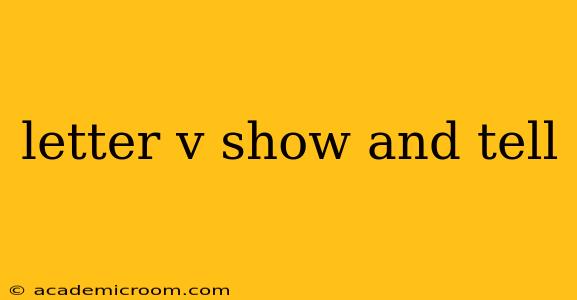Show and tell is a fantastic way to boost a child's confidence, vocabulary, and communication skills. Focusing on a specific letter, like "V," adds an extra layer of learning and fun. This guide offers engaging activities and ideas to make your letter V show and tell a resounding success.
What are some things that start with the letter V?
This is a classic show and tell opener! Encourage children to think beyond the obvious. While "van" and "violin" are easy choices, prompting them to consider less common words like "vegetable," "vest," or "volcano" enhances their vocabulary and problem-solving skills. Encourage visual aids; a picture of a volcano alongside a small toy van makes the presentation more engaging.
How can I make my letter V show and tell presentation interesting?
The key is to go beyond simply showing an object. Incorporate storytelling, sensory elements, and interactive components. For example:
- Visual Aids: Use flashcards, pictures, or even a short video clip related to the chosen "V" word.
- Interactive Elements: Ask questions to the audience, such as "Have you ever seen a volcano erupt?" or "What kind of vegetables do you like to eat?"
- Sensory Engagement: If showing a velvet fabric, let the audience feel its texture. If presenting a video of a vibrant violet flower, describe its scent and color.
- Storytelling: Weave a short story around your object. For instance, a story about a van traveling across the country, visiting different places starting with "V" (like Vermont or Virginia).
What are some good examples of letter V items for show and tell?
Here's a diverse list, encouraging creativity beyond the basic:
- Vehicles: Vans, Vespas, vintage cars. Encourage children to share details about their chosen vehicle, such as its color, make, or a special memory related to it.
- Vegetables: Vibrant vegetables like violets (a purple flower, but still works!), various types of peppers, or even a vibrant visual representation of a vegetable garden.
- Clothing: Vests, velvet dresses or shirts (emphasize texture), or even a visual of a Victorian-era outfit.
- Animals: While fewer common animals start with V, you can creatively include visuals of a variety of venomous snakes or other creatures with V-related attributes. This opens up discussions on animal habitats and characteristics.
- Verbs in Action: This is a more advanced option. Children could demonstrate verbs starting with V (e.g., "visit," "vanish") through role-playing or short skits.
How can I help my child prepare for a letter V show and tell?
Preparation is key! Help your child:
- Brainstorm Ideas: Make a list together of potential items.
- Practice the Presentation: Encourage them to practice what they'll say beforehand.
- Create Visual Aids: Help them make flashcards or posters.
- Choose an Item They're Passionate About: This will make the presentation more engaging and confident.
- Rehearse with Questions: Prepare answers to potential questions from their audience.
What if my child is shy about doing a letter V show and tell?
Shyness is normal! Here's how to help:
- Practice Makes Perfect: Rehearse the presentation multiple times in a comfortable environment.
- Start Small: Begin with a smaller audience (family members) before presenting to a larger group.
- Positive Reinforcement: Praise their effort and focus on their accomplishments, not just their presentation’s perfection.
- Make it Fun: Focus on the enjoyment of sharing, rather than pressure to perform flawlessly. Use a rewarding system such as stickers.
By employing these strategies, you can transform your letter V show and tell into an engaging, educational, and memorable experience for your child. Remember, the goal is to foster confidence and communication skills, not just perfect pronunciation.
